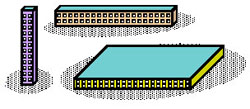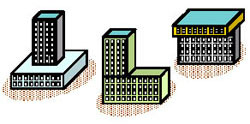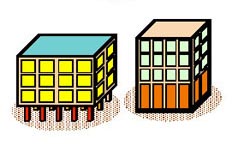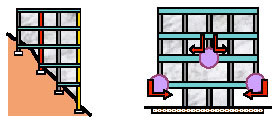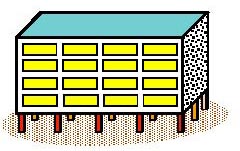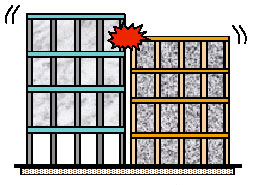|
How Architectural
Features Affect Building During Earthquakes?
Importance of Architectural Features The behaviour of a building during earthquakes depends critically on its overall shape, size and geometry, in addition to how the earthquake forces are carried to the ground. Hence, at the planning stage itself, architects and structural engineers must work together to ensure that the unfavourable features are avoided and a good building configuration is chosen. The importance of the configuration of a building was aptly summarised by Late Henry Degenkolb, a noted Earthquake Engineer of USA, as: “If we have a poor configuration to start with, all the engineer can do is to provide a band-aid - improve a basically poor solution as best as he can. Conversely, if we start-off with a good configuration and reasonable framing system, even a poor engineer cannot harm its ultimate performance too much.”
A desire to create an aesthetic and functionally efficient structure drives architects to conceive wonderful and imaginative structures. Sometimes the shape of the building catches the eye of the visitor, sometimes the structural system appeals, and in
other occasions both shape and structural system work together to make the structure a marvel. However, each of these choices of shapes and structure has significant bearing on the performance of the building during strong earthquakes. The wide range of structural damages observed during past earthquakes across the world is very educative in identifying structural configurations that are desirable versus those which must be avoided.
In general, buildings with simple geometry in plan (Figure 2a) have performed well during strong earthquakes. Buildings with re-entrant corners, like those U, V, Hand + shaped in plan (Figure 2b), have
sustained significant damage. Many times, the bad effects of these interior corners in the plan of buildings are avoided by making the buildings in two parts. For example, an L-shaped plan can be broken up into two rectangular plan shapes using a separation joint at the junction (Figure 2c). Often, the plan is simple, but the columns/walls are not equally distributed in plan. Buildings with such features tend to twist during earthquake shaking. A discussion in this aspect will be presented in the upcoming IITK-BMTPC Earthquake Tip 7 on How Buildings Twist During Earthquakes?
Buildings on a sloping ground have unequal height columns along the
slope, which causes ill effects like twisting and damage in shorter
columns (Figure 3c). Buildings with columns that hang or float on
beams at an intermediate storey and do not go all the way to the
foundation, have discontinuities in the load transfer path (Figure
3d). Some buildings have reinforced concrete walls to carry the
earthquake loads to the foundation. Buildings, in which these walls
do not go all the way to the ground but stop at an upper level ,are
liable to get severely damaged during earthquakes.
Adjacency of Buildings
ncrease in building height, this collision can be a greater problem. When building heights do not match (Figure 4), the roof of the shorter building may pound at the mid-height of the column of the taller one; this can be very dangerous.
Looking ahead, of course, one will continue to make buildings interesting rather than monotonous. However, this need not be done at the cost of poor behaviour and earthquake safety of buildings. Architectural features that are detrimental to earthquake response of buildings should be avoided. If not, they must be minimised. When irregular features are included in buildings, a considerably higher level of engineering effort is required in the structural design and yet the building may not be as good as one with simple architectural features. Decisions made at the planning stage on building configuration are more important, or are known to have made greater difference, than accurate determination of code specified design forces.
Arnold, C., and Reitherman, R., (1982), Building Configuration and Seismic Design, John Wiley, USA. Lagorio, H,J, (1990), EARTHQUAKES An Architect’s Guide to Non-Structural Seismic Hazard, John Wiley & Sons, Inc., USA.
Authored by: C.V.R. Murty Indian Institute of Technology Kanpur, India Sponsored by: Building Materials and Technology Promotion Council, New Delhi.
Suggestions/comments may be sent to eqtips@iitk.ac.in To see previous IITK-BMTPC Earthquake Tips, visit www.nicee.org q |
||||||||||||||||||||||||||||||||||||||||||||
